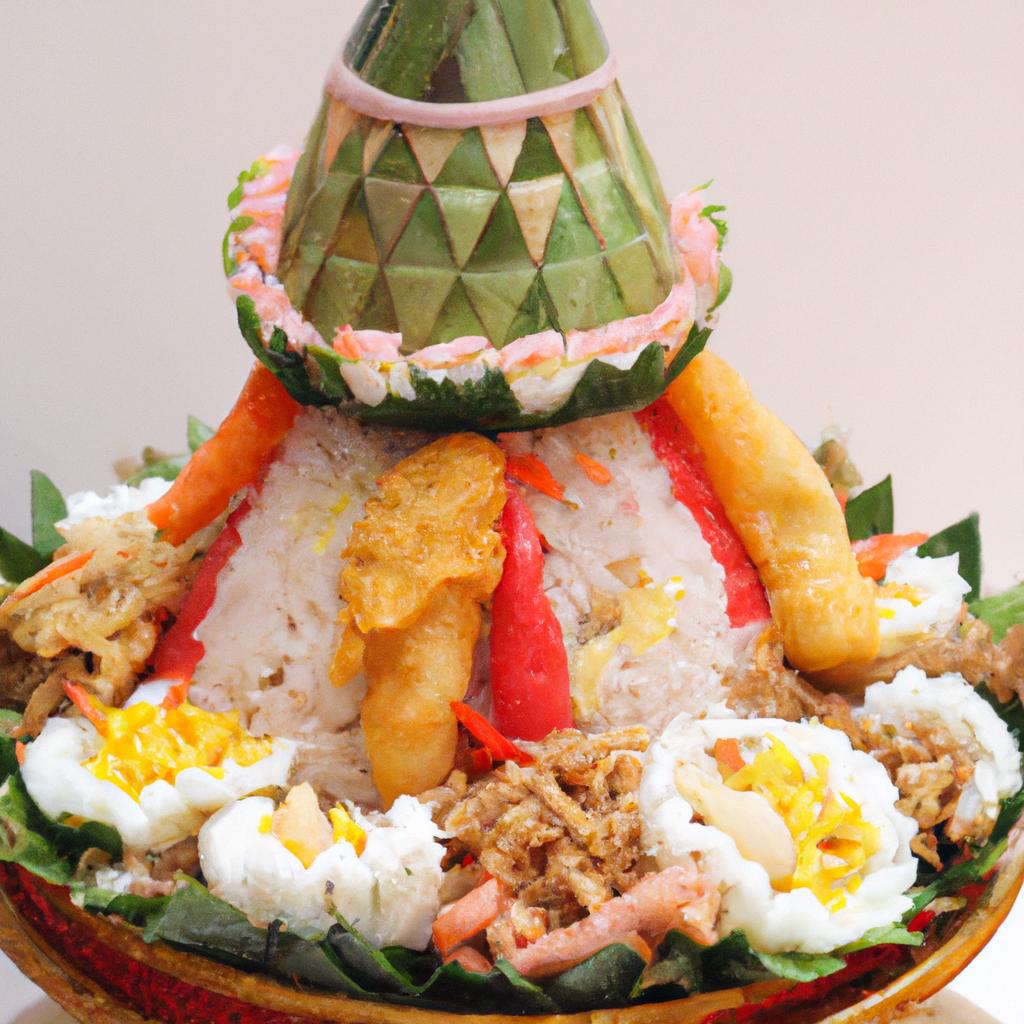Nasi tumpeng - cone-shaped rice

Indonesia is a vibrant and diverse country that boasts of a rich culinary history. One of its most distinctive and popular dishes is Nasi Tumpeng, a cone-shaped rice dish that is often served during important celebrations and ceremonies.
Nasi Tumpeng is a traditional Indonesian dish that is usually served during special occasions, including birthdays, weddings, and religious festivals. The dish comprises a cone-shaped mound of rice, often yellow from being cooked with turmeric, and is accompanied by various side dishes that are carefully placed around the rice. The sides usually include various meats, vegetables, and shrimp crackers.
The cone-shaped rice symbolizes a mountain or a symbol of prosperity in traditional Javanese culture. It also represents harmony and unity as the dish is meant to be shared with family and friends.
Nasi Tumpeng is a dish that has a long and fascinating history. It is believed that the dish first originated in Java and was served during ancient Javanese royal ceremonies. The dish was seen as a symbol of honor and respect, and it was often served to royalty and nobility during these occasions.
Over time, Nasi Tumpeng has grown in popularity and has become a revered and cherished dish among Indonesians. Today, the dish is enjoyed by people from all walks of life, from small villages in rural areas to major cities, and is often served in restaurants and at home.
The preparation of Nasi Tumpeng requires a certain level of skill and attention to detail. The rice is often cooked with coconut milk, turmeric, and other spices to give it a distinct flavor and aroma. The side dishes that accompany the rice are carefully chosen and arranged based on their colors, textures, and flavors to create a harmonious and satisfying meal.
The side dishes that are commonly served with Nasi Tumpeng often include a variety of meats like chicken, beef or lamb, seafood, and vegetables. The sides can be stir-fried, grilled, or steamed, and are often seasoned with various spices, such as garlic, ginger, lemongrass, and chili.
Shrimp crackers, known as krupuk, are often laid around the base of the cone-shaped rice. These crackers are made from flour and dried shrimp, and they add a crispy texture and salty flavor to the dish.
Nasi Tumpeng is a dish that reflects Indonesia’s cultural diversity and its love for food. The preparation of the dish varies from region to region and from family to family. It is a dish that is meant to be shared, enjoyed, and savored, and it is a testament to the warmth and generosity of the Indonesian people.
In conclusion, Nasi Tumpeng is a unique and remarkable dish that is steeped in tradition and history. Its distinct shape, vibrant colors, and bold flavors make it a culinary treasure that is loved and cherished by Indonesians from all walks of life. So why not try making this impressive dish for your next celebration or gathering and experience the flavors of Indonesia for yourself?
Ingredients:
- 2 cups of jasmine rice
- 3 cups of water
- 1 teaspoon of salt
- 3 pandan leaves
- 2 lemongrass sticks
- 2 turmeric leaves
- 2 salam leaves
- 1 tablespoon of coconut oil
- 1/4 cup of fried shallots
Instructions:
- Rinse the rice until the water runs clear and drain.
- In a pot, add the water, pandan leaves, lemongrass sticks, turmeric leaves and salam leaves. Bring to a boil and then remove the leaves from the pot, leaving only the water.
- Add the rice and salt to the pot and stir.
- Bring the mixture to a boil, then reduce the heat and let it simmer until the liquid has been absorbed and the rice is fully cooked.
- Remove the pot from the heat and let the rice cool for 10 minutes.
- Once the rice has cooled, transfer it into a cone-shaped container.
- Press down on the rice to create a cone shape, then remove the container.
- Top the rice with fried shallots and serve.
Optional: Serve with various side dishes, such as fried chicken, tempeh, tofu, and vegetables.